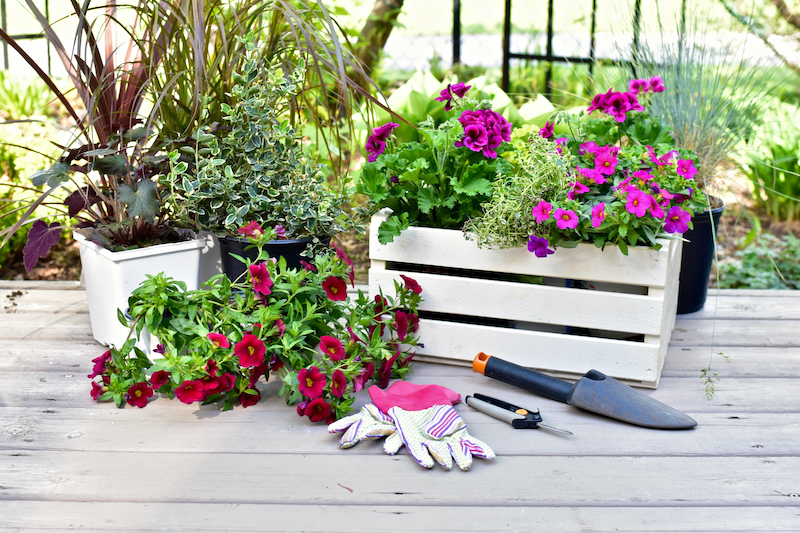At Home
How Does Your Garden Grow?
 Spring is an amazing time of year in the garden. Plants that have been sleeping all winter are coming back to life, and new growth is getting ready to appear for the first time. With a little bit of planning, and some expert advice, your lawn, flowerbeds and vegetable gardens can be the envy of the neighbourhood.
Spring is an amazing time of year in the garden. Plants that have been sleeping all winter are coming back to life, and new growth is getting ready to appear for the first time. With a little bit of planning, and some expert advice, your lawn, flowerbeds and vegetable gardens can be the envy of the neighbourhood.
Preparation is the key to successful gardening. So grab a gardening journal and make some notes.

Don’t Leave Things Covered
Estelle Laporte of J.A. Laporte Flowers and Nursery in Orleans, Ontario hasn’t met a plant that wouldn’t grow for her.
“My first and best advice when gardening in the spring — don’t leave things covered too long,” says Laporte. “Take your covers off before your plants overheat. Push back the mulch and soil, pull off the burlap, and let air in.”
If you’re moving into a new home she recommends finding out from previous owners how old the flowerbeds and vegetable garden are.
“If beds have been there quite a number of years use some slow release fertilizer to get them started in the spring,” says Laporte. “Buy fertilizer specific to the plant you are dealing with, and use that fertilizer at least a couple of times over the course of the summer. If you move into a home that obviously has older beds you can rejuvenate them, or you can rip out the existing plants, take care of the soil, then add new plants. Soil does get weak. Mix together some sheep manure, chicken manure, or some shrimp compost with your soil. Add nutrients. Your plants are alive. Don’t let them starve; if they are old they need more help. Carefully work the soil around mature plants, so not to damage the roots.”

Transplanting Plants
A favourite flowerbed may have a large clump of flowers that require separation into two or more clumps – to be transplanted into other areas of the garden. Keep in mind, flowers that bloom in the spring should not be separated in the spring, or they simply won’t bloom. For example bleeding heart, peonies, iris, daffodils, or tulips.
“They’ll bloom the next year, but not the year you separate and transplant them,” says Laporte. “However, if the garden contains ornamental grasses the spring is a good time to separate them. Unless they have only been in the ground for one year, then wait until the next spring. Grasses just get better and better with separation.”
Gardening tools must be cleaned and sharpened in the spring as well she says. Sharpened sheers and even spades make the work much easier.
“Particularly in the case of military families moving from province to province. You wouldn’t want to bring a plant disease along with you, and introduce it to your new neighborhood. Don’t forget to clean your boots too. Rubbing alcohol works really well. Cleaning and maintaining tools should be part of, not only your spring gardening regime, but something gardeners make a habit of. One set of sheers can spread a canker from one branch through an entire cherry tree. If you deal with a sick branch, clean off your sheers before going at the rest of the tree.”

Container Gardening
If you don’t have a large space and you still want the beauty of natural plants you can try container gardening. “The size of the pot is important – the larger the pot the better your plants will grow, simply because they will not dry out easily.” Therefore, the bigger the pot the less maintenance required.
Soil must be taken seriously when container gardening as well. Use the right soil for the right job. Vegetables must have vegetable soil because soil for flowers is not sterilized. “Buy your plants at a local nursery. You may pay a bit more, but you’ll actually have a great vegetable yield and that will make it worthwhile. Also you can ask which variety of peppers, tomatoes, or peas grow best in your area,” says Laporte. “Not all varieties like all areas of the country. What you grew in Nova Scotia may not thrive in Saskatchewan.”

Seek Professional Advice
Also, consulting a reputable gardening professional, can save money.
“The place to go is an established nursery, not an inexperienced sales person in a seasonal garden centre,” she says. “A professional will know what the growing season is going to be like, and have documented the local weather for years.” Military families moving from province to province need to double check their ‘plant knowledge’ with a professional because Victoria, Ottawa, and Gander all have very different climates, native plants, and different growing conditions, advises Laporte.

Best Kit to Own
What is the best piece of kit for the average gardener?
“I would recommend that anyone who is unsure of their soil condition, or who moves to a new property buy a soil test kit in the spring,” says Laporte. “You test the soil yourself, then you take the results to a nursery and they will recommend the right nutrition for your flowerbeds, your lawn, or your veggie garden. How easy is that? No wasting money on soil or fertilizer you don’t need.”
There may come a time when the average gardener realizes they are in over their head. Perhaps they have a bigger gardening project, like a retaining wall, stone walkway, or substantial perennial garden they want to tackle.

Hiring a Professional Landscape Designer
Hiring a landscaper can be an intimidating process, because there are so many people out there professing to be in the landscape business. Jason Smalley of Jason Smalley Landscape Design in Ottawa, Ontario offers the following advice for people considering hiring a landscaper this spring.
“I would recommend hiring a Certified Landscape Designer, Technician, or Professional. Those are all designations under the Canadian Nursery and Landscape Association. Each province has a board, and you’ll see on people’s websites whether they are members,” says Smalley.
Membership with the CNLA is an indication the person being hired is a professional with some education, experience and a portfolio of work.
“You really have a couple of choices. You can hire an independent landscaper, or you can hire a design-build company who employs a landscaper. Think of it this way, a design-build company has their own equipment, trucks, excavators, and saws to do stonework. They employ the designer. They employ the labourers. They give you a packaged product. An independent landscape designer works with you to design the project, choose its features, and then brings in other specialized contractors and equipment necessary to get the job done. Either way, the main thing to consider is hiring a company with a good reputation, look at their work if possible.”

Things to Consider
Follow-up and follow-through are very important. Make sure the landscaper or design-build company guarantees their work for a period of time.
“Sometimes things happen that may be weather related or unforeseen, but a reputable landscaper will even guarantee plants if they die, not due to neglect on the part of the homeowner, but disease,” says Smalley.
Always make sure the person or company being considered has a viable portfolio. “You need to know if they have a good sense of style” says Smalley. “That means from the plants, to the trees, to the stone walkway the new landscaping matches or melds with the existing architecture of your home and the existing landscaping. If you’re planning a spring project, start researching now. The more ideas the client comes to the table with the better. It streamlines the process, saving time.”
Finally, the best gardening advice for moving military families is this: if it makes you sad to leave your plants behind, plant them in large, sturdy plastic pots in the ground. When it’s time to go, dig them up and tell the kids to move over, because the bleeding heart is coming along for the ride.
Please visit Jason Smalley here. http://jsld.ca










